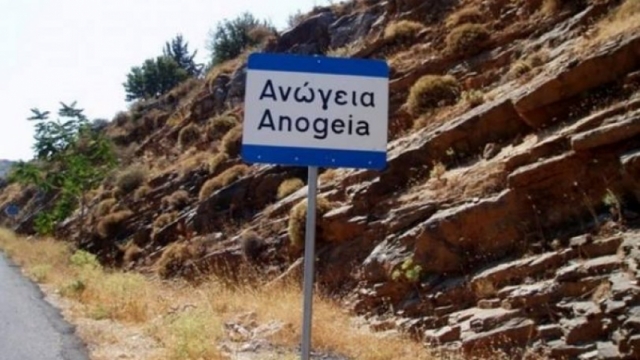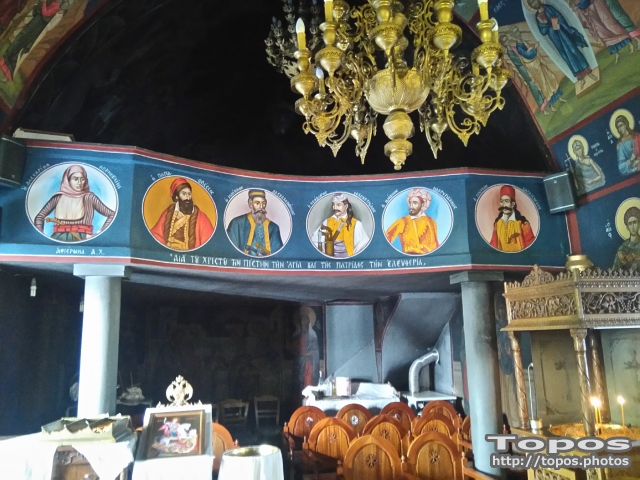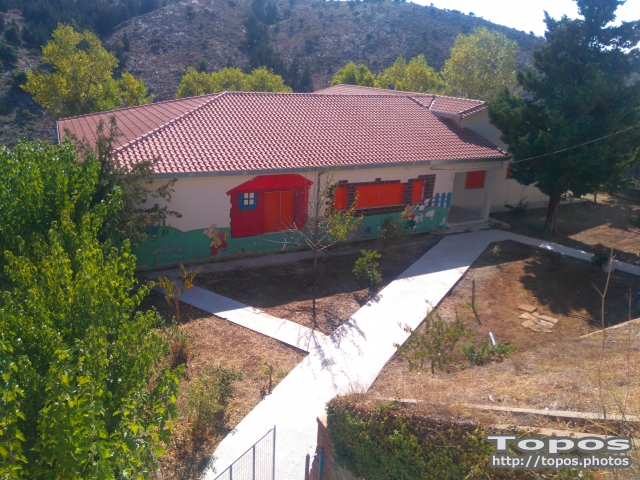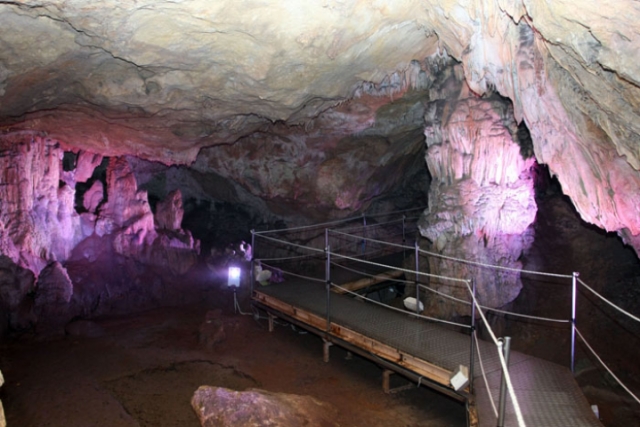Your Position:
Unknown
Λεπτομέρειες ΕικόναςImage details
More Photos
Press here.
Panagia Rousolimniotisa
Prefecture: Rethymno
, Suggest
Your Opinion

If you want to tell us your opinion about this place, please leave a comment
Post a Comment:
Places near Panagia Rousolimniotisa
Zominthos (Greek: Ζώμινθος, alternative spellings Ζόμινθος or Ζόμιθος) is a small plateau in the northern foothills of Mount Ida (Psiloritis), οn the island of Crete. Zominthos is roughly 7.5 kilometers west of the village of Anogia, on the path from Knossos to Idaion Andron, the great sanctuary cave near the peak of Ida. Zominthos is best known for the large Minoan building discovered there; signs of permanent settlement date back to about 1800 BC.
Professor Yannis Sakellarakis discovered the site in 1982, during his first day of excavations at the nearby Ideon Andron Cave by Psiloritis mountain, close to Anogia Village, when a shepherd told him about his pastures and sheep in an area called “Zominthos.”
Intrigued by the pre-Hellenic place-name, he began small-scale excavations the following year, which revealed the Central Building that is now believed to have dominated one of the main Minoan routes up to Mount Ida, today called Psiloritis. Zominthos may have been used as a rest stop for visitors making their way from Knossos to the Ideon Cave, the great sanctuary cave near the peak of Ida, as is mentioned in Plato’s Laws (book I, 625B): “I dare say that you will not be unwilling to give an account of your government and laws; on our way we can pass the time pleasantly in and about them, for I am told that the distance from Knossos to the cave and the temple of Zeus is considerable; and doubtless there are shady places under the lofty trees, which will protect us from this scorching sun.”
Zominthos seems to have been occupied beginning the 17th century B.C., with an extensive settlement and a monumental Central Building that covers an area of 1,600 square meters (17,000 square feet). Beneath the Central Building, which was gradually developed from the 17th century onward, the remains of several earlier structures have been identified. Because of the severe climate conditions on the mountaintop—including snow during the winter months—the site may not have been used throughout the entire year, but rather as a seasonal habitat. During the summer months, people likely moved their flocks of sheep here, to higher altitudes, while exploiting natural resources, such as minerals, herbs, and pharmaceutical plants. These products, along with woolen textiles and olives, were the goods most commonly exported from Minoan Crete to Egypt and the Middle East.
The Central Building is extremely well preserved and some of its walls still stand at a height of 2.2 meters (7.2 feet). However, creating the foundation of such a huge building at this altitude is quite a complicated issue. Its unlikely location and size, as well as its careful construction, indicate the existence of a central authority that intended to control the region’s resources, including its flocks and pastures. Zominthos may therefore be considered a well-organized administrative complex—built on a strategic spot for the control of the area—that fully adapted to the inhospitable Cretan mountains. Its location on the ancient route to Psiloritis and the wealth of pottery found at the site indicate that it was likely also a religious and crafts center.
The accounting archives in the Linear B script from the palace at Knossos—about 40 kilometers (25 miles) from Zominthos—record thousands of sheep along with shepherds’ names. However, the location of the land where these sheep were grazing has always been a mystery. Zominthos and the neighboring regions have very prosperous pastures, so it could be that the sheep recorded in the Knossos tablets were mainly concentrated here at Zominthos. The Central Building’s importance is confirmed by its asymmetrical facades and orientation to the cardinal points, which are well-known characteristics of Minoan palaces. Zominthos was destroyed by an earthquake around 1600 B.C., which resulted in a fire that devastated the vast majority of building’s structure. But various finds from the Central Building indicate that the site continued to be used in Mycenaean, Archaic, Hellenistic, and Roman times.
After a gap of 17 years, archaeological work at the site of Zominthos resumed in the summer of 2005. Although only the ground floor is visible today, archaeological evidence suggests that the Central Building had at least two floors built of large blocks of local stone, some coated with white plaster and decorated with frescoes. Only 10 of at least 45 rooms of the ground floor have been partly or fully explored up to now, and the results can be summarized as follows: The rooms contained pottery, masses of animal bones, numerous fragments of carbonized wood, and several small artifacts. The vast majority of the pottery includes conical cups, cooking pots, and pithoi. Also, several ceramic water conduits have been found, probably indicating a central drainage system. In the western part of the Central Building, a complex consisting of at least two workshops was discovered.
The artistic events, which take place every year in the first week of July at the same place called Fourni and in the Cretan village of Anogia are thus called YAKINTHIA.The idea to build a church at the same place came from the Archbishop of Rethymnon, Anthymos, who himself laid down the foundation stone.
The chapel is built in the shape of a Crete "mitato", a circular building made of flat stones without mortar 1.200 m above sea level. The building was realized after the rules of the Late Minoan architecture with a dome. The inclination starts above 2 meters and leaves a hole of 30 cm at the top. The planning and control was realized by the architect Stavros Vidalis.
http://yakinthia.com/
The village is the seat of the municipal district. It is located at an altitude of 600m and was built the 13th century. The settlement is reported, during Venetian rule, by Barozzi, Kastrofilaka and Basilicata. It is one of few villages in Crete, where there is an increase of population happening during the last few years.
It is one of the more important livestock farming villages of Milopotamos, with 28.000 to 30.000 sheep and goats. It also produces raisins. Finally, the last few years it has seen an impressive growth in the craft of weaving.
The villagers have participated in the Revolution of 1866. Here, the General Assembly of Cretans (September 1868) signed a resolution, addressed to the Great Powers, informing them about the situation inCrete.
The canyon of Zoniana is located south of Zoniana village at the north side of Idi or Psiloritis mountains, Rethimno prefecture. Starting at an altitude of 950m, it ends at the south side of the village at an altitude of 650m.
Through the gorge runs the "serpentine" Oaxis river that has water till spring. The gorge is easily accessible and safe for hiking, as its slope is small. Zoniana village is a mountainous village of Milopotamos province belonging to Rethimnon Prefecture in Crete. It is built on an altitude of about 640 metres. It has a population of about 1,500 inhabitants, the majority of whom are occupied with agriculture and cattle-breeding. It is situated 43km away from the capital city of Heraklion, but it is also a nice excursion from Rethymnon.
Through the gorge runs the "serpentine" Oaxis river that has water till spring. The gorge is easily accessible and safe for hiking, as its slope is small. Zoniana village is a mountainous village of Milopotamos province belonging to Rethimnon Prefecture in Crete. It is built on an altitude of about 640 metres. It has a population of about 1,500 inhabitants, the majority of whom are occupied with agriculture and cattle-breeding. It is situated 43km away from the capital city of Heraklion, but it is also a nice excursion from Rethymnon.
Zoniana village is a mountainous village of Milopotamos province belonging to Rethimnon Prefecture in Crete. It is built on the northern foot of Psiloritis mountain (Mount Ida) in an altitude of about 640 metres. It has a population of about 1,500 inhabitants, the majority of whom are occupied with agriculture and cattle-breeding. The legends and traditions which accompany it are lost in the depths of time. Through these pages one can find out how the village was named, how one can visit it, learn about its history, look at several of its pictures and some other interesting sights, and finally read some myths and legends related to it.The history of the village is lost in the depths of time since according to the legend its formation and name are closely related to Zeus. It also coincides with the history of Axos since the province of the village was part of its realm as well as the area of Anogeia.In 1577 Barozzi cites it as a separate settlement with the name So. Since then the separate history of the village begins for which, however, we do not have any written documents until 1821. Nevertheless, both the recent past and the present of Zoniana manifest its farther past. One thing is beyond the shadow of doubt: that it was never inhabited by Saracen, Venetian or Turkish conquerors, that its population has always been purely Greek and that it always took part whenever Greece called for help. In more detail, the inhabitants of Zoniana participated in the Revolution of 1770 in every way they could and also took care of persecuted Sfakians.In 1821 M. Melitakas from “Zou Lakko (Zoniana) Mylopotamou (it is written in one paint of him at Historical Museum of Heraklio, Crete )”, chieftain of Milopotamos province, fought against the Turks throughout Crete. He got injured in a battle in Brachimio and died because of that wound later. His name is reported at the Book of V. Psilakis “Istoria tis Kritis” page 320. In 1866 twenty inhabitants of Zoniana with Parassirogiorgis decided to leave the safety that the mountains offered them and go to Arcadi, where seventeen of them were killed.Six months later, on May 8 1867, the inhabitants of Zoniana along with those from Milopotamos stroke Omer Pasha Latas in Pera Chalepa. The Turks beat a hasty retreat and the inhabitants of Zoniana took a portable canon as loot, carried it to Zoniana and hid it. Today this canon is in the Maritime Museum of Crete in Chania. On the next day, May 9, the numerous Turkish army wore down the resistance of the inhabitants of Zoniana and entered the village. They interrogated the old and the sick who could not leave the place in order to find the canon. Since no one confessed, they slaughtered everyone and set the village in fire. Along with it the forest of the gorge was also burnt.In November of the same year Kumandar Redic Pasha tried to build a Tower in Kafkaloudi (Amigdalokefalo) like in all the other villages. He did not succeed to do so because the inhabitants of Zoniana did not leave him at ease. Day and night they attacked him and then left (klephtopolemos) and they decimated his soldiers and builders. In turn, he burnt everything that the inhabitants of Zoniana had managed to rebuild and departed. This clearly demonstrates that the village of Zoniana was set on fire twice within six months (both in May and November). According to a song of that period the village had been burnt yet another time: “That’s the third time that the village is burnt but even if it is burnt three hundred times we will not obey the Aghas.”The years went by but the inhabitants of Zoniana did not cease to fight the Turks. They went to Gazi and Servili and along with the inhabitants of Milopotamos and Malevizio they trapped the Turks in Heraclion. There is still today in Gazi a location called “Michanes” which took its name from the conduits that the inhabitants of Zoniana dug and then blew up as the Turks were getting closer. During a battle in which the rebels beat a hasty retreat, they left the flag behind. The inhabitant of Zoniana Michalis Kavvalos or Kaprakis got back and in a cloud of bullets he took it and left. For that reason he was awarded a prize by the Cretan community as the saver of the flag. That is the place where Michalis Nikiforos was killed.During the Balkan Wars thirteen inhabitants of Zoniana sacrificed their lives. During World War II (Northern Epirus – the Battle of Crete – the Greek Occupation) nineteen inhabitants of Zoniana were sacrificed in the name of Greece.Last but not least, during the Greek Civil War another four people lost their lives. Maybe those were the only lives lost in vain however they obeyed to the calls of the Greek government.Text: www.zoniana.gr
Settlement of Livadia district that lies at an altitude of 610m and it is known since 1577.
The name of the village comes from the Dorian krini, testifiying that the village has a very long history indeed. The residents of the settlement participated in the revolutionary war of 1868.








